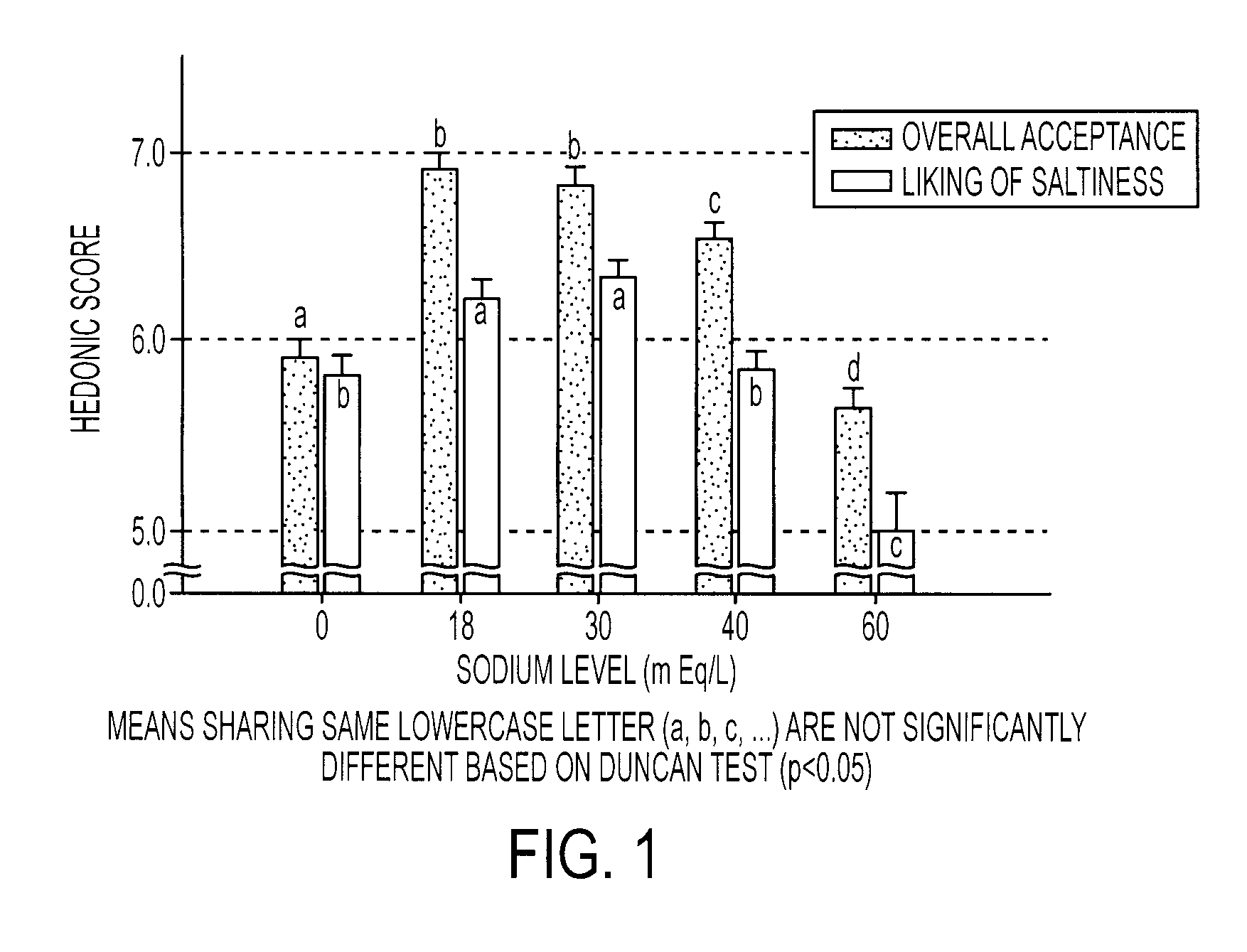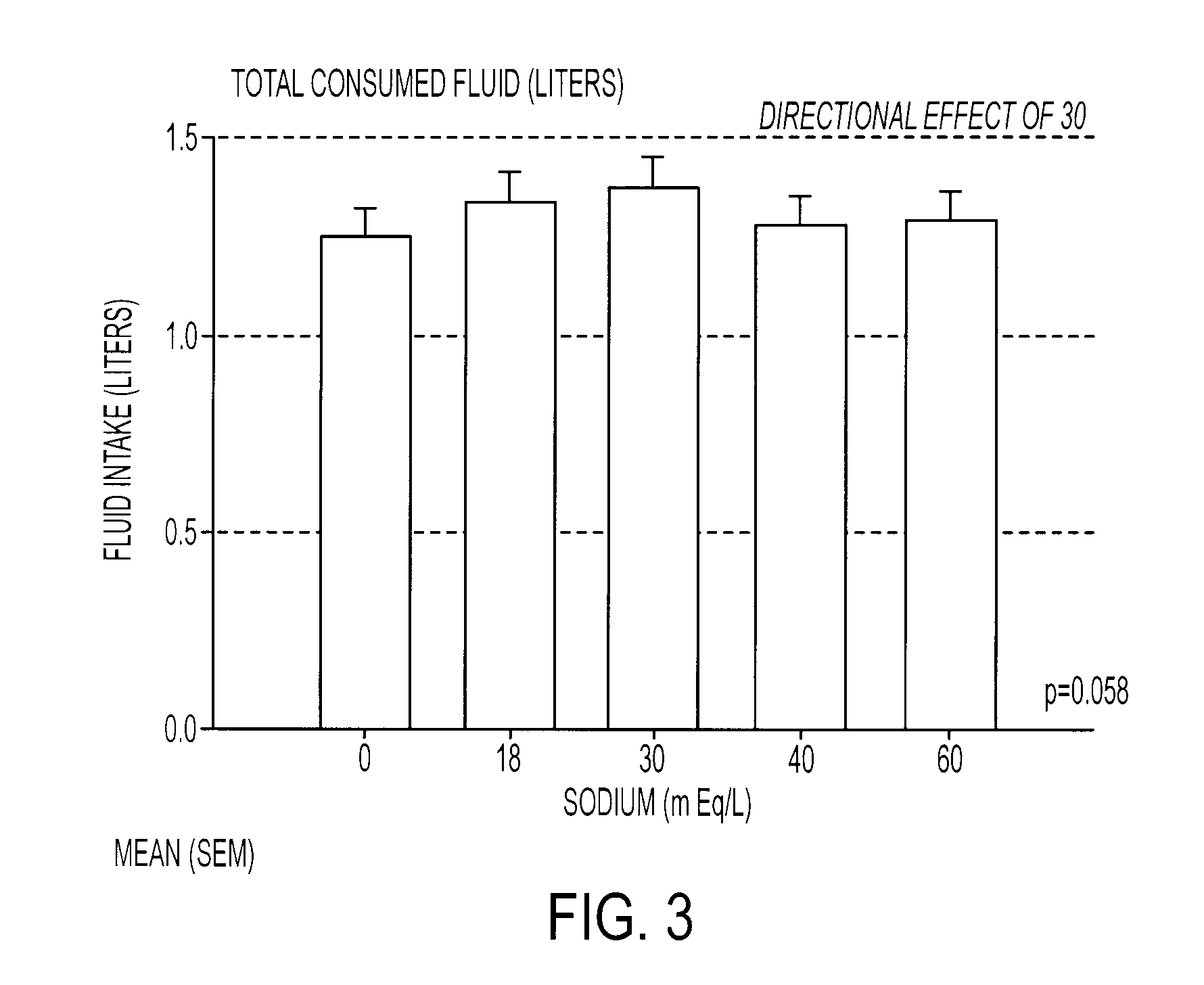Carbohydrate And Electrolyte Replacement Composition
a technology of carbohydrate and electrolyte, applied in the direction of drug composition, extracellular fluid disorder, metabolism disorder, etc., can solve the problems of reducing the drinking response, preventing adequate rehydration, and not considering the palatableness of fluid replacement beverages containing an increased amount of sodium
- Summary
- Abstract
- Description
- Claims
- Application Information
AI Technical Summary
Benefits of technology
Problems solved by technology
Method used
Image
Examples
example 1
[0085]A formulation designated as G30 was evaluated for sensory properties against four other formulations containing the typical ingredients found in commercial sports drinks. The G30 formulation consisted of a 6% carbohydrate solution in water, 30 mEq / L of sodium, 3 mEq / L potassium, about 10 mEq / L of chloride, 25 ppm of a clouding agent and 0.103% by weight of a flavoring agent. The carbohydrate solution was prepared using a mixture 3% sucrose, 1.7% glucose, and 1.3% fructose. In addition, both sodium chloride and sodium citrate were used to provide the sodium ions. The comparison formulations contained the exact ingredients except that the sodium levels of these beverages were modified so that the first formulation, designated as G0, contained 0 mEq / L of sodium, the second formulation, designated as G18, contained 18 mEq / L of sodium, the third formulation, designated as G40, contained 40 mEq / L of sodium, and the fourth formulation, designated as G60, contained 60 mEq / L of sodium....
example 2
[0087]The same formulations were used to determine the ad libitum drinking characteristics, sensory aspects, hydration characteristics, and voluntary fluid intake for each. Fifty subjects completed almost all testing and were included in the subject pool used for analyses. Of this 50, 28 were men (m age 39.7±8.0) and 22 were women (m age 37.2±9.2). For the complete pool, the average number of workout hours per week was 11.25±6.8 (range 1-35) and the average number of races participated in per year was 11.0±8.4 (range 0-35). All subjects were given dietary and exercise guidelines as follows: No heavy exercise on the day before testing. Allow at least one full day of recovery between sessions. No caffeine the day of testing. No high salt or high fat foods the evening before or the day of the testing. Do not eat within 3 hours of testing. Drink a liter of water 3 hours before testing. Void urine prior to testing.
[0088]All subjects were required to follow the diet and exercise guideline...
example 3
[0097]This study compared all the formulations except the G40 formulation to determine how rapidly fluid is lost and how much is retained up to three hours after exercise-induced dehydration that is followed by replacement of total sweat loss. This was conducted in a double-blind experimental design with formulations counterbalanced among the study group.
[0098]Subjects were fed a standard diet for dinner (the evening prior to testing), breakfast, and lunch. The total caloric intake was 2440 calories and 2592 mg of sodium. Meals were accompanied with 500 ml of water.
[0099]All subjects were required to follow the diet and exercise guidelines prior to participating. In order to assure pre-experiment hydration, each subject was required to ingest adequate fluid. Pre-experiment hydration was further assured by checking the conductivity / osmolality of the baseline urine sample prior to the testing. Subjects whose urine sample exceeded 21 milliSiemens (mS) were dismissed from the experiment...
PUM
 Login to View More
Login to View More Abstract
Description
Claims
Application Information
 Login to View More
Login to View More - R&D
- Intellectual Property
- Life Sciences
- Materials
- Tech Scout
- Unparalleled Data Quality
- Higher Quality Content
- 60% Fewer Hallucinations
Browse by: Latest US Patents, China's latest patents, Technical Efficacy Thesaurus, Application Domain, Technology Topic, Popular Technical Reports.
© 2025 PatSnap. All rights reserved.Legal|Privacy policy|Modern Slavery Act Transparency Statement|Sitemap|About US| Contact US: help@patsnap.com



